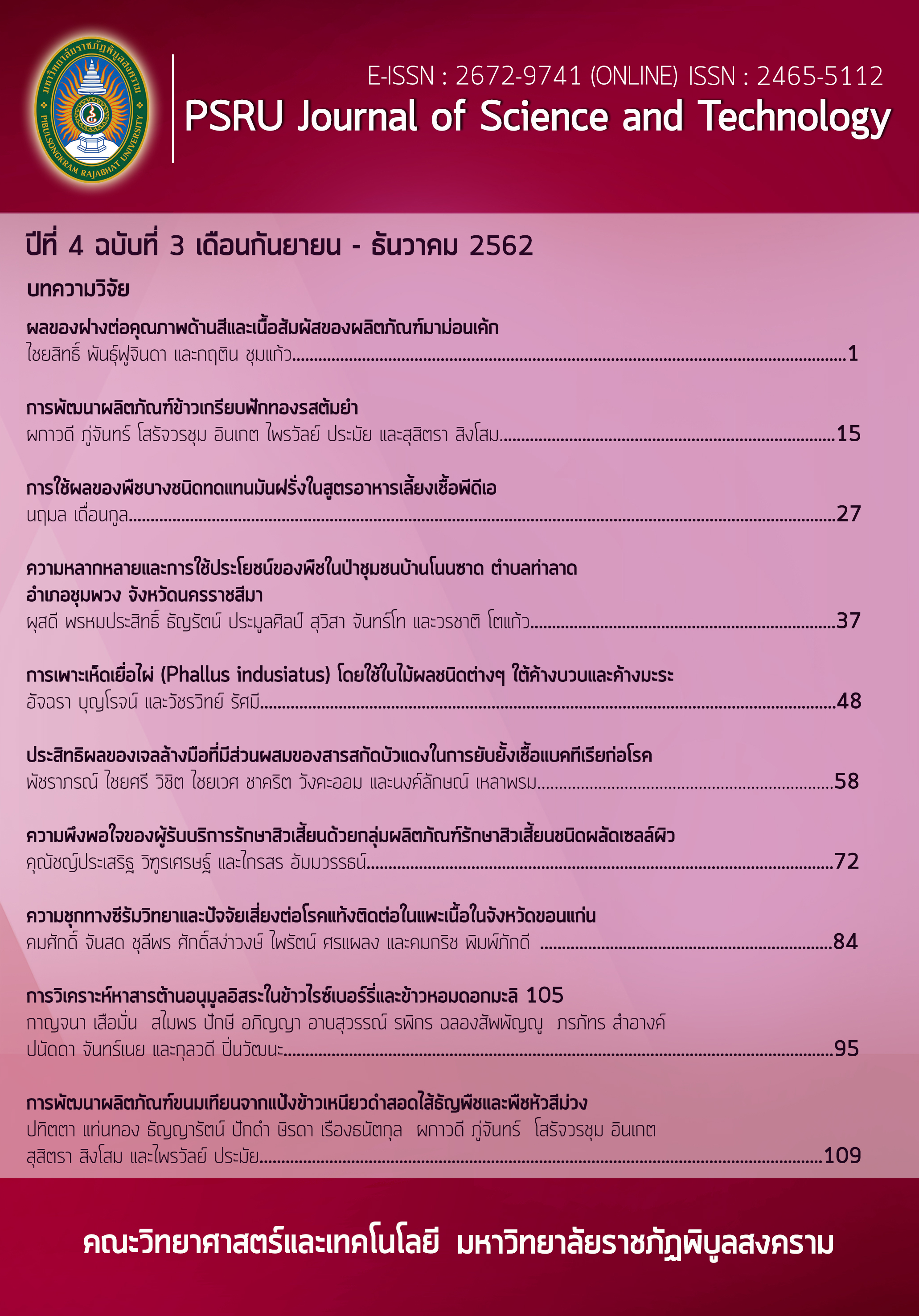DETERMINATION OF ANTIOXIDANT CAPACITY OF RICEBERRY AND KHAO DOK MALI 105 CULTIVARS
Keywords:
antioxidant, Riceberry, Khao Dok Mali 105, anthocyaninAbstract
The propose of this research was to determine and compare the antioxidant properties of brown rice and colorless brown rice with germination and cooking process. The 2,2-diphenyl-1- picrylhydrazyl was employed to analyze the antioxidant capacity. It was found that the Riceberry cultivar with red-purple color showed the antioxidant capacity higher than Khao Dok Mali 105 cultivar (KDML 105). The antioxidant value was found to be TEAC 883.03 of Riceberry cultivar and 690.14 μmol/g of KDML105 cultivars, respectively. The cooking process was applied to rice of both cultivars, it was found this process reduces the antioxidant capacity to 3.57% and 3.81% of cooked Riceberry and cooked KDML105 cultivar, respectively. Moreover, both cultivars were germinated by soaked for 12 hours and allow to germination for 2 days. The antioxidant capacity of both cultivars (Germinated Riceberry and Germinated KDML105) was decreased after the germination process. However, germinated and cooked Riceberry contains the antioxidant activity higher than germinated and cooked KDML105 at the ratio of 2.16 folds. Suggested that, anthocyanin compound which found in red-purple color rice of Riceberry cultivar may enhance the antioxidant activity of color rice. Moreover, the germination process in this study does not affect to increase the antioxidant activity, while the cooling process will reduce the antioxidant activity of both cultivars.
References
วัชรี หาญยิ่ง. (2549). อนุมูลอิสระและสารต้านอนุมูลอิสระในกลไกของการเกิดมะเร็ง. วารสารวิทยาศาสตร์มหาวิทยาลัยขอนแก่น, 34(3), 199-208.
ศิริพร คำชุ่ม. (2559). การพัฒนาเครื่องดื่มข้าวหมากจากข้าวมีสีที่มีฤทธิ์ต้านอนุมูลอิสระ. วิทยานิพนธ์ปริญญาวิทยาศาสตรมหาบัณฑิต (สาขาวิทยาศาสตร์และเทคโนโลยีการอาหาร). มหาวิทยาลัยราชภัฏพิบูลสงคราม, พิษณุโลก.
Chutipaijit S., Cha-um S. and Sompornpailin K. (2009). Differential accumulations of proline and flavonoids in Indica rice varieties against salinity, Pak. J. Bot., 41(5), 2497-2506.
Daiponmak W., Theerakulpisut P., Thanonkao P., Vanavichit A. and Prathepha P. (2010). Changes of anthocyanin cyaniding-3-glucoside content and antioxidant activity in Thai rice varieties under salinity stress. Science Asia, 36, 286-291.
Department of Science Service. (2010). Anthocyanin. Bangkok: Ministry of Science and Technology. (in Thai).
Ghosh SK., Missra A., Gilmour DS. (2011). Negative elongation factor accelerates the rate at which heat shock genes are shut off by facilitating dissociation of heat shock lactor. Mol. Cell Biol., 31, 4232-4243.
Umnajkitikorn K., Faiyue, B. and Saengnil K. (2013). Enhancing Antioxidant Properties of Germinated Thai rice (Oryza sativa L.) cv. Kum Doi Saket with Salinity. J. Rice Res., 1, 1-8.
Urtgam, S. and Jongjitvimol, T. (2019). Landrace Rice in Phitsanulok Province. PSRU Journal of Science and Technology, 4(1), 19-27.
Walter M., Marchesan E., Massoni P.F.S., Silva L.P.D., Sartori G.M.S. and Ferreira R.B. (2013). Antioxidant properties of rice grains with light brown, red and black pericarp colors and the effect of processing. Food Res Int, 50, 698-730.
Wang R. (1999). Quantitative structure-activity relationship analysis of phenolic antioxidants. Shandong Medical University, Jinan, Shandong 250012, P. R. China, 26, 285-294.
Yawadio R., Tanimori S. and Morita N. (2007). Identification of Phenolic compounds isolated from pigmented rices and their aldose reductase inhibitory activities. Food Chem., 101, 1616-1625.
Zhang M., Guo B., Zhang R., Chi J., Wei Z., Xu Z., Zhang Y. and Tang X. (2006). Separation, purification and identification of antioxidant compositions in blank rice. Agr Sci China., 5, 431-440.
Downloads
Published
How to Cite
Issue
Section
License
กองบรรณาธิการขอสงวนสิทธิ์ในการปรับปรุงแก้ไขตัวอักษรและคำสะกดต่างๆ ที่ไม่ถูกต้อง และต้นฉบับที่ได้รับการตีพิมพ์ในวารสาร PSRU Journal of Science and Technology ถือเป็นกรรมสิทธิ์ของคณะวิทยาศาสตร์และเทคโนโลยี มหาวิทยาลัยราชภัฏพิบูลสงคราม และ
ผลการพิจารณาคัดเลือกบทความตีพิมพ์ในวารสารให้ถือมติของกองบรรณาธิการเป็นที่สิ้นสุด







